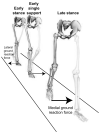Contributions of muscles to mediolateral ground reaction force over a range of walking speeds
- PMID: 22884038
- PMCID: PMC3438315
- DOI: 10.1016/j.jbiomech.2012.06.037
Contributions of muscles to mediolateral ground reaction force over a range of walking speeds
Abstract
Impaired control of mediolateral body motion during walking is an important health concern. Developing treatments to improve mediolateral control is challenging, partly because the mechanisms by which muscles modulate mediolateral ground reaction force (and thereby modulate mediolateral acceleration of the body mass center) during unimpaired walking are poorly understood. To investigate this, we examined mediolateral ground reaction forces in eight unimpaired subjects walking at four speeds and determined the contributions of muscles, gravity, and velocity-related forces to the mediolateral ground reaction force by analyzing muscle-driven simulations of these subjects. During early stance (0-6% gait cycle), peak ground reaction force on the leading foot was directed laterally and increased significantly (p<0.05) with walking speed. During early single support (14-30% gait cycle), peak ground reaction force on the stance foot was directed medially and increased significantly (p<0.01) with speed. Muscles accounted for more than 92% of the mediolateral ground reaction force over all walking speeds, whereas gravity and velocity-related forces made relatively small contributions. Muscles coordinate mediolateral acceleration via an interplay between the medial ground reaction force contributed by the abductors and the lateral ground reaction forces contributed by the knee extensors, plantarflexors, and adductors. Our findings show how muscles that contribute to forward progression and body-weight support also modulate mediolateral acceleration of the body mass center while weight is transferred from one leg to another during double support.
Copyright © 2012 Elsevier Ltd. All rights reserved.
Figures






Similar articles
-
Muscle coordination of mediolateral balance in normal walking.J Biomech. 2010 Aug 10;43(11):2055-64. doi: 10.1016/j.jbiomech.2010.04.010. Epub 2010 May 7. J Biomech. 2010. PMID: 20451911
-
Contributions of muscles and passive dynamics to swing initiation over a range of walking speeds.J Biomech. 2010 May 28;43(8):1450-5. doi: 10.1016/j.jbiomech.2010.02.009. Epub 2010 Mar 16. J Biomech. 2010. PMID: 20236644 Free PMC article.
-
How gravity and muscle action control mediolateral center of mass excursion during slow walking: a simulation study.Gait Posture. 2014 Jan;39(1):91-7. doi: 10.1016/j.gaitpost.2013.06.004. Epub 2013 Jun 28. Gait Posture. 2014. PMID: 23816462
-
Contributions of muscles to terminal-swing knee motions vary with walking speed.J Biomech. 2007;40(16):3660-71. doi: 10.1016/j.jbiomech.2007.06.006. Epub 2007 Jul 19. J Biomech. 2007. PMID: 17659289 Free PMC article.
-
Contributions to the understanding of gait control.Dan Med J. 2014 Apr;61(4):B4823. Dan Med J. 2014. PMID: 24814597 Review.
Cited by
-
Effects of walking speed on gait biomechanics in healthy participants: a systematic review and meta-analysis.Syst Rev. 2019 Jun 27;8(1):153. doi: 10.1186/s13643-019-1063-z. Syst Rev. 2019. PMID: 31248456 Free PMC article.
-
Multi-Site Identification and Generalization of Clusters of Walking Behaviors in Individuals With Chronic Stroke and Neurotypical Controls.Neurorehabil Neural Repair. 2023 Dec;37(11-12):810-822. doi: 10.1177/15459683231212864. Epub 2023 Nov 17. Neurorehabil Neural Repair. 2023. PMID: 37975184 Free PMC article.
-
Effect of core training on skill-related physical fitness performance among soccer players: A systematic review.Front Public Health. 2023 Jan 5;10:1046456. doi: 10.3389/fpubh.2022.1046456. eCollection 2022. Front Public Health. 2023. PMID: 36684974 Free PMC article.
-
Comparison of gluteus medius strength between individuals with obesity and normal-weight individuals: a cross-sectional study.BMC Musculoskelet Disord. 2021 Jun 25;22(1):584. doi: 10.1186/s12891-021-04470-8. BMC Musculoskelet Disord. 2021. PMID: 34172038 Free PMC article.
-
Recreational runners who recovered from COVID-19 show different running kinetics and muscle activities compared with healthy controls.Gait Posture. 2022 Jan;91:260-265. doi: 10.1016/j.gaitpost.2021.11.002. Epub 2021 Nov 6. Gait Posture. 2022. PMID: 34775229 Free PMC article.
References
-
- Abel MF, Damiano DL. Strategies for increasing walking speed in diplegic cerebral palsy. J Pediatr Orthop. 1996;16:753–758. - PubMed
-
- Agiovlasitis S, McCubbin JA, Yun J, Mpitsos G, Pavol MJ. Effects of Down syndrome on three-dimensional motion during walking at different speeds. Gait Posture. 2009;30:345–350. - PubMed
-
- Andriacchi TP, Johnson TS, Hurwitz DE, Natarajan R. Musculoskeletal Dynamics, Locomotion, and Clinical Applications. In: Mow, Huiskes, editors. Basic Orthopaedic Biomechanics and Mechano-Biology. 3rd ed Lippincott Williams & Wilkins; Philadelphia, PA: 2005. pp. 91–122.
-
- Ashley MJ, Gryfe CI, Annies A. A longitudinal study of falls in an elderly population. II. Some circumstances of falling. Age Ageing. 1977;6:211–220. - PubMed
-
- Cappellini G, Ivanenko YP, Poppele RE, Lacquaniti F. Motor patterns in human walking and running. J Neurophysiol. 2006;95:3426–3437. - PubMed
Publication types
MeSH terms
Grants and funding
LinkOut - more resources
Full Text Sources

